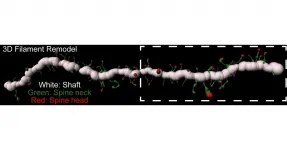Results of the Phase I study of the 90-day dual-purpose ring are being presented at the HIV Research for Prevention (HIVR4P) Virtual Conference, or HIVR4P // Virtual, which is taking place over the course of four days: Jan. 27-28 and Feb. 3-4.
The study, MTN-044/IPM 053/CCN019, was conducted by researchers from the National Institutes of Health (NIH)-funded Microbicide Trials Network (MTN) in collaboration with NIH's Contraceptive Clinical Trials Network (CCTN) and is the first to evaluate the ring's use, as intended, for 90 days. In an earlier first-in-human study (MTN-030/IPM 041), also conducted by the MTN, women used the ring for 14 days with no safety concerns.
The 90-day dual-purpose ring is one of two next-generation vaginal rings being developed by the nonprofit International Partnership for Microbicides (IPM) - the other being a 90-day dapivirine-only ring for HIV prevention alone. Both products build on IPM's monthly dapivirine ring, which last year received a positive opinion from the European Medicines Authority (EMA) for its use among cisgender women ages 18 and older in developing countries, and soon after, was added to the World Health Organization (WHO) list of pre-qualified medicines. IPM is now seeking the ring's approval in several African countries, as well as from the U.S. Food and Drug Administration. If approved, the monthly dapivirine ring would be the first biomedical HIV prevention method designed specifically for cisgender women and the first long-acting method.
"It is so exciting to see the dapivirine ring nearing the finish line, and we can only hope that other HIV prevention products for women will follow. If there's one thing we've learned from our experience with contraception uptake and delivery, it's important that women have options, because they have different needs and preferences at different times in their lives," says Sharon L. Achilles, M.D., Ph.D., associate professor of obstetrics, gynecology and reproductive sciences at the University of Pittsburgh School of Medicine and director of the Magee-Womens Research Institute's Center for Family Planning Research.
"That's why a product that could protect against both HIV and unwanted pregnancy might be especially attractive to many women," added Dr. Achilles, who is protocol chair of the MTN-044/IPM 053/CCN019 study and will be reporting its results at the meeting. Dr. Achilles led the first Phase I study as well.
Whereas the monthly ring contains 25 mg of dapivirine, the dual-purpose ring contains 200 mg of dapivirine to allow for its extended release over three months, as well as 320 mg of levonorgestrel, a synthetic progestin used in many contraceptives, either alone or in combination with estrogen.
Because irregular bleeding or spotting is a common side effect of progestin-only contraceptives, Dr. Achilles and her team wanted to know whether the same would be true with use of the 90-day ring and whether removing the ring for a couple days each month, as is commonly done for other contraceptives, would reduce or eliminate irregular bleeding. Importantly, the study aimed to determine whether there would be sustained release of dapivirine and levonorgestrel over the course of 90 days - at levels thought to be sufficient for HIV protection and contraception - and the impact that periodic removals of the ring might have. This would be especially important to understand, because as a user-controlled method, it is likely to be removed from time to time anyway.
The study enrolled 25 women at Magee-Womens Hospital of UPMC in Pittsburgh, who were randomly assigned to use the combination dapivirine-levonorgestrel ring continuously for 90 days or cyclically for 90 days - three cycles during which the ring was used for 28 days and removed for two days.
Bleeding patterns experienced by participants were nearly identical in the two groups, and generally reassuring. Of the more than 2,100 total days of ring use across both groups, 58 percent were without bleeding and 31 percent only spotting. Likewise, moderate bleeding was reported to occur only 10 percent of the days and heavy bleeding only accounted for 1-2 percent of the days in each group. There were no significant product-related safety concerns.
When the ring was in place, the amount of dapivirine in plasma was well above levels observed in the Phase III efficacy trials of the 25 mg ring. While dapivirine levels decreased when the ring was removed, they remained within the range seen in the Phase III trials with the lower dose ring. Likewise, levonorgestrel levels in plasma remained consistent with those required for effective contraception. With respect to dapivirine levels in vaginal fluid, there was a rapid and steep decline after the ring's removal.
"Because cyclic use is a common practice with many hormonal contraceptives, and, as a user-controlled product, periodic removal of the ring can be expected, we wanted to understand the impact this behavior would have on both bleeding patterns and HIV protection. So far, it does not appear likely that cyclic use will make a difference in bleeding patterns, but it remains to be seen whether or not periodic removals will allow for sustained protection against HIV infection. This is something that we will need to study further," commented Dr. Achilles.
While adherence to ring use was high - about 91 percent - more than 25 percent of the participants said they removed the ring at least once during the study. At the same time, 19 of the 25 participants, or 76 percent, reported that their ring partially come out on its own on one or more occasion and that for 10 women (40 percent), the ring fell out completely at least once. Unlike the monthly and 90-day tenofovir rings, the combination dapivirine-levonorgestrel ring evaluated in the study was made to be more pliable and had a softer feel, which the researchers believe is the likely reason for the many expulsions. IPM has since reformulated the ring, which it now plans to evaluate in a trial to be conducted in partnership with the CCTN, part of the Eunice Kennedy Shriver National Institute of Child Health and Human Development.
"We have heard from women around the world that they want and need new multipurpose prevention choices they can use on their own terms. Today's encouraging results support the continued development of the dapivirine-contraceptive ring, and we are working to incorporate the valuable insights gained from this study to optimize the ring's formulation," said Bríd Devlin, IPM's executive vice president for product development. "We are optimistic that the dapivirine-contraceptive ring will further expand women's sexual and reproductive health choices."
The results of the MTN-044/IPM 05/CCN019 study will be presented by Dr. Achilles in a session called "Multipurpose prevention technologies (MPTs) for prevention of HIV and pregnancy," which is part of the Jan. 28 program of HIVR4P // Virtual.
Also to be reported in the same session are preliminary results of MTN-045, or the CUPID Study, which involved interviews with 400 couples in Uganda and Zimbabwe about their views and preferences for potential dual-purpose products. More than 90 percent of the couples liked the idea of a two-in-one product, especially if framed first, and foremost, as a contraceptive rather than a method for HIV prevention.
Results of the Phase I study (MTN-036/IPM 047) of the 90-day dapivirine-only ring have been accepted for presentation at the upcoming Conference on Retroviruses and Opportunistic Infections (CROI), March 7-10.
INFORMATION:
To learn about the MTN-044/IPM 053/CCN019 study of the dual-purpose vaginal ring, go to https://www.mtnstopshiv.org/research/studies/mtn-044.
To learn more about the International Partnership for Microbicides, the monthly dapivirine ring and next-generation products, visit https://www.ipmglobal.org/
The MTN is supported by the U.S. National Institutes of Health grants UM1AI068633, UM1AI068615, UM1AI106707. MTN-044 was supported by NICHD Contraceptive Clinical Trial Network contract HHSN275201200002I Task order HHSN27500005.
About the Microbicide Trials Network
The Microbicide Trials Network (MTN) is an HIV/AIDS clinical trials network established in 2006 by the National Institute of Allergy and Infectious Diseases with co-funding from the Eunice Kennedy Shriver National Institute of Child Health and Human Development and the National Institute of Mental Health, all components of the U.S. National Institutes of Health. Based at Magee-Womens Research Institute and the University of Pittsburgh, the MTN brings together international investigators and community and industry partners whose work is focused on the rigorous evaluation of promising microbicides - products applied inside the vagina or rectum that are intended to prevent the sexual transmission of HIV - from the earliest phases of clinical study to large-scale trials that support potential licensure of these products for widespread use. More information about the MTN is available at http://www.mtnstopshiv.org.




